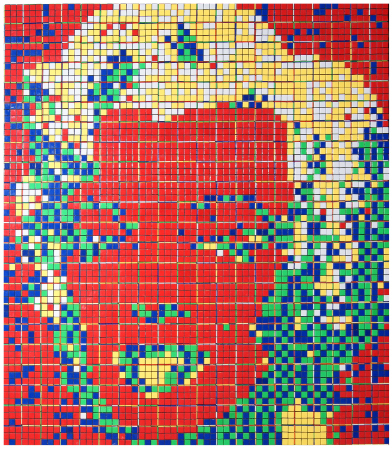Lesson 2: Square Roots and Cube Roots
Module 2: Roots and Powers
Explore
Do you know the name of the famous celebrity portrayed in this artwork? It is composed of more than 400 Rubik’s Cubes! A special property of the number 400 is that it is a perfect square. In this lesson you will continue to explore perfect squares and perfect cubes, and you will investigate how you can find their roots.

Cube Works Studio, Toronto.
Glossary Terms
Add the following terms to your "Glossary Terms" section in your notes.- cube root
- perfect cube
- perfect square
- square root
------------------------------------------------
A perfect square is any whole number that can be represented as the area of a square with a whole number side length. The length of the square is the square root. For example, imagine a piece of art like the one in the photograph is made out of 256 Rubik’s Cubes. The number 256 is a perfect square since a square with an area of 256 square units has a side length of 16 units, a whole number. On the other hand, while it is possible to have a square with an area of 300 square units, the side length of the square would not be a whole number.
Similarly, a perfect cube is any whole number that can be represented as the volume of a cube with a whole number side length. The length of the cube is the cube root. For example, the number 8 is a perfect cube since a cube with a volume of 8 cubic units has a side length of 2 units, a whole number.
There are many ways to determine if a number is a perfect square or a perfect cube:
- manipulatives and diagrams
- prime factorization
- guess and check
- calculator
 Math Lab: Manipulatives
Math Lab: Manipulatives
Complete Math Lab: Manipulatives in your course folder ( binder). The lab will help you identify perfect squares and perfect cubes by using manipulatives to build squares and cubes. Before you begin, print (or copy by hand) a copy of Perfect Squares and Perfect Cubes Data Sheet.
Materials
- 150 counters or pennies
- 150 unit blocks or sugar cubes
- printed copy of data sheet – Perfect Squares and Perfect Cubes Data Sheet
Procedure
The following steps assume you are using pennies and sugar cubes, but you could also use counters and unit blocks respectively.
Step 1: Arrange the pennies or sugar cubes into squares with different side lengths. Record the total number of pennies or cubes used for each square in the first table on the data sheet.
Analysis
Answer the following questions:
1. Which numbers less than 150 are perfect squares?
2. Which numbers less than 150 are perfect cubes?
3. How could you use a sheet of graph paper, instead of counters or pennies, to do Step 1 in the procedure?
4. What other methods could you use to determine whether a number is a perfect square or a perfect cube?
Use the link provided below to check your answers
Math Lab: Manipulatives Answers
____________________________________________________________________
Diagrams
If you are going to draw diagrams, it really helps if you have graph paper available. Also, the diagram method works best for smaller numbers; you don’t really want to draw a diagram to figure out if 4096 is a square number! For large numbers, you may want to begin with the guess and check method.
If you were asked if 196 was a square number, you could pull out your graph paper and begin counting 196 squares, remembering the shape you draw must be a square. (Each side must be the exact same length.)
This diagram has 196 squares and it is a square shape, so you know that 196 is a perfect square.

To find the square root of 196, find the length of each side.
Each side is 14 units long, so 14 × 14 = 196. The square root of 196 is 14.
Prime Factorization
Another way you can identify perfect squares and perfect cubes is to use prime factorization.
Recall your data from the Math Lab in this lesson. You were asked to express 144 as a product of primes. Your result should have looked like this:
144 = 2 × 2 × 2 × 2 × 3 × 3
You can rearrange the prime factors into two identical groups:
144 = (2 × 2 × 3) × (2 × 2 × 3)
This result can be simplified:
144 = 12 × 12
This means that you can use 144 pennies to create a square with a side length of 12. In other words, 144 is a perfect square with a square root of 12.